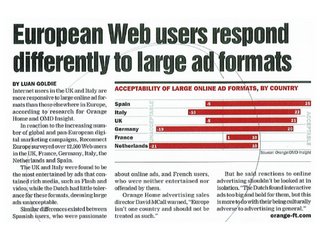Technology has fundamentally changed how brands and their audiences communicate, not just online but across all channels. Consequently interactive thinking needs to be at the heart of all marketing strategy and interactive channels at the heart of all marketing delivery.
Monday, July 31, 2006
Viral-video makers walking creative fine line
In just over five years, viral Web video has grown from an underground phenomenon into a $100 million to $150 million industry, according to estimates. But with this success comes the need to keep users entertained with more creative -- and expensive -- concepts, while avoiding the appearance of being too mainstream.
Video game ads becoming more mainstream
With around 75% of the online population in the U.S. playing games for at least an hour a month, according to one report, it's no wonder that gaming companies are looking to market these popular, well-trafficked platforms to advertisers.
http://www.usatoday.com/tech/gaming/2006-07-10-ad-games_x.htm
http://www.usatoday.com/tech/gaming/2006-07-10-ad-games_x.htm
Marketers find themselves in online avatars
Marketers like ESPN, L'Oreal, DaimlerChrysler AG and others are using animated images or avatars, sometimes representing advertising icons or even their chief executives, to generate online marketing buzz.
http://www.washingtonpost.com/wp-dyn/content/article/2006/07/14/AR2006071401587.html
http://www.washingtonpost.com/wp-dyn/content/article/2006/07/14/AR2006071401587.html
Big business tries to make friends and influence people online
THE internet sensation that is MySpace continues to grow at an astonishing rate. The social-networking site had 17m unique monthly visitors last July, when Rupert Murdoch recast himself as an internet visionary by buying it for $580m; now it has 54m, and is the most visited website in America. Even if, judging by recent headlines, many visitors are prowling paedophiles or panicking parents spying on their sex-crazed children, at least some of them are the valuable youngsters to which many big firms yearn to sell things.
MySpace seems to offer a chance for companies to take their marketing into new, potentially more lucrative territory, by becoming, in effect, members of their customers' network of "friends". A growing number of firms have established their own pages on MySpace, to which users can link. In the process, some are getting into bed with some unlikely partners. Earlier this year, for example, Unilever, a consumer-goods giant, hooked up with Christine Dolce to promote Axe, a deodorant. Ms Dolce, who goes by the alias ForBiddeN, boasts around 900,000 "friends" who link to her MySpace page. Bleached, buxom and with impressive marketing savvy, she is arguably the most successful brand to emerge from MySpace, and has already launched a line of clothing.
That made her perfect, Unilever concluded, to draw in the 18- to 24-year-old lustful lads to whom Axe is shamelessly marketed. So Ms Dolce hosted an interactive game, called "Gamekillers", based around dating tips and designed subtly to promote Axe. Some 75,000 MySpacers signed up for it.
The biggest challenge—for MySpace itself, and for the firms that want to use it to promote their wares—is not to alienate potential customers by being overtly commercial. "We need to be engaging with them, not banging them over the head with brandalism that pollutes their space," says Kevin George of Unilever. But, he says, "when you deliver 18- to 24-year-old guys content they want to engage with, they don't mind if it comes from a brand." This theory will now be put to the test, as MySpacers' attention is fought over by brands including Procter & Gamble's Old Spice, State Farm insurance, Elexa by Trojan female condoms, and the US Marine Corps.
http://www.economist.com/research/articlesBySubject/PrinterFriendly.cfm?Story_ID=7233972&subjectID=526352
MySpace seems to offer a chance for companies to take their marketing into new, potentially more lucrative territory, by becoming, in effect, members of their customers' network of "friends". A growing number of firms have established their own pages on MySpace, to which users can link. In the process, some are getting into bed with some unlikely partners. Earlier this year, for example, Unilever, a consumer-goods giant, hooked up with Christine Dolce to promote Axe, a deodorant. Ms Dolce, who goes by the alias ForBiddeN, boasts around 900,000 "friends" who link to her MySpace page. Bleached, buxom and with impressive marketing savvy, she is arguably the most successful brand to emerge from MySpace, and has already launched a line of clothing.
That made her perfect, Unilever concluded, to draw in the 18- to 24-year-old lustful lads to whom Axe is shamelessly marketed. So Ms Dolce hosted an interactive game, called "Gamekillers", based around dating tips and designed subtly to promote Axe. Some 75,000 MySpacers signed up for it.
The biggest challenge—for MySpace itself, and for the firms that want to use it to promote their wares—is not to alienate potential customers by being overtly commercial. "We need to be engaging with them, not banging them over the head with brandalism that pollutes their space," says Kevin George of Unilever. But, he says, "when you deliver 18- to 24-year-old guys content they want to engage with, they don't mind if it comes from a brand." This theory will now be put to the test, as MySpacers' attention is fought over by brands including Procter & Gamble's Old Spice, State Farm insurance, Elexa by Trojan female condoms, and the US Marine Corps.
http://www.economist.com/research/articlesBySubject/PrinterFriendly.cfm?Story_ID=7233972&subjectID=526352
Subscribe to:
Posts (Atom)
